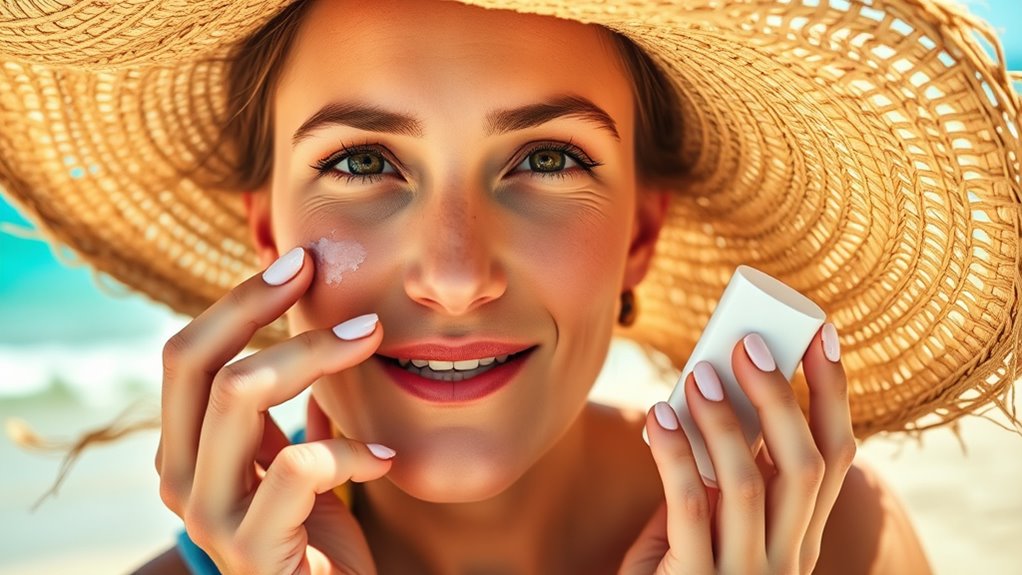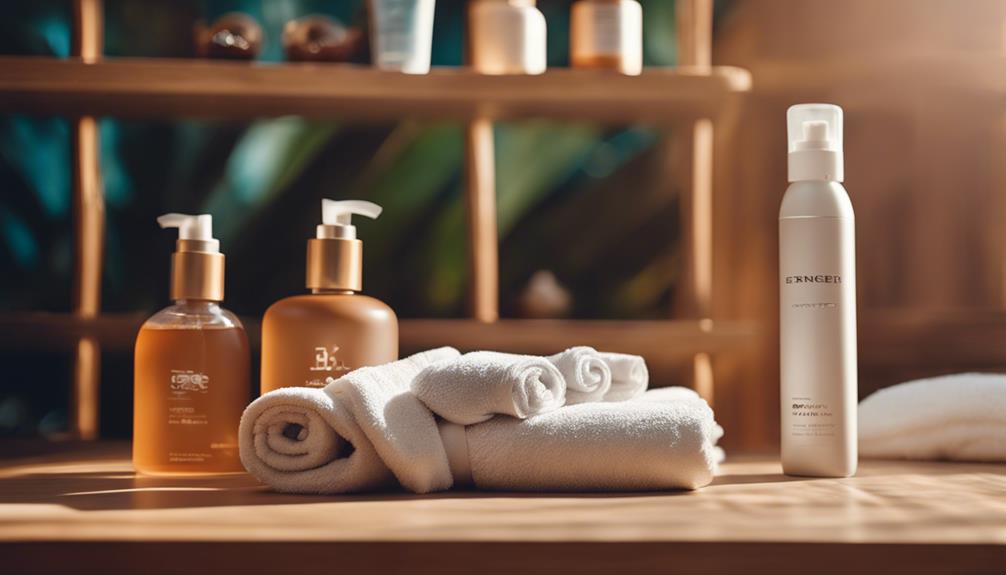To protect your skin during summer, use a broad-spectrum sunscreen with SPF 30+ and reapply every two hours, especially after swimming or sweating. Wear protective clothing like wide-brimmed hats and sunglasses, and seek shade during peak hours. Stay hydrated, eat antioxidant-rich foods, and watch for signs of sun damage like fine lines or dark spots. Incorporating the right sunscreen and protective strategies helps keep your skin youthful and healthy all season. Learn more about effective sun safety tips below.
Key Takeaways
- Use broad-spectrum SPF 30+ sunscreen daily and reapply every two hours during outdoor activities.
- Wear protective clothing like hats, long sleeves, and UV sunglasses to physically block harmful rays.
- Seek shade during peak hours (10 a.m. to 4 p.m.) and limit direct sun exposure.
- Stay hydrated and consume antioxidant-rich foods to support skin health and repair sun damage.
- Incorporate skincare with antioxidants and soothing ingredients like aloe vera for post-sun recovery.
Understanding the Impact of UV Rays on Your Skin
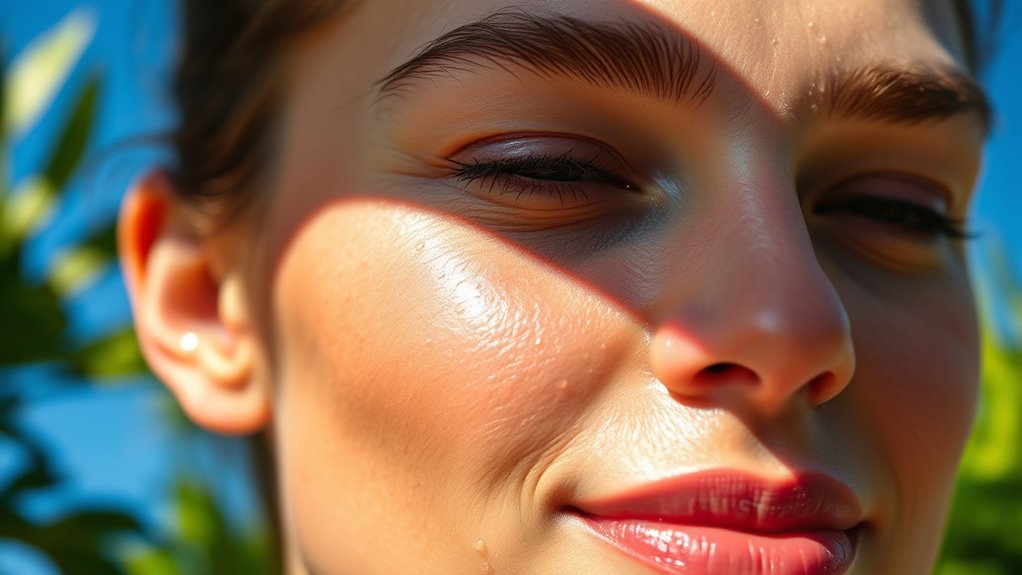
Since UV rays are strongest during summer, understanding their impact on your skin is essential for protecting yourself. UV radiation can penetrate your skin layers, leading to early aging signs like wrinkles and sunspots. It damages the DNA in skin cells, increasing the risk of skin cancer over time. UVB rays mainly cause sunburns, while UVA rays contribute to deeper skin aging and long-term damage. Even on cloudy days, UV rays can reach your skin, so protection is vital year-round. Without proper defense, your skin’s natural collagen and elastin fibers weaken, making your skin less firm and more prone to discoloration. Recognizing the harmful effects of UV rays helps you take proactive steps to safeguard your skin throughout the summer. Incorporating natural materials into your skincare routine can also help boost your skin’s resilience against UV damage. Additionally, using essential oils with protective and soothing properties can enhance your skincare regimen and provide extra defense against sun-related harm. Being aware of UV penetration can help you choose more effective sun protection strategies and products, especially when considering skin barrier health and its role in blocking harmful UV rays.
Choosing the Right Sunscreen for Your Skin Type
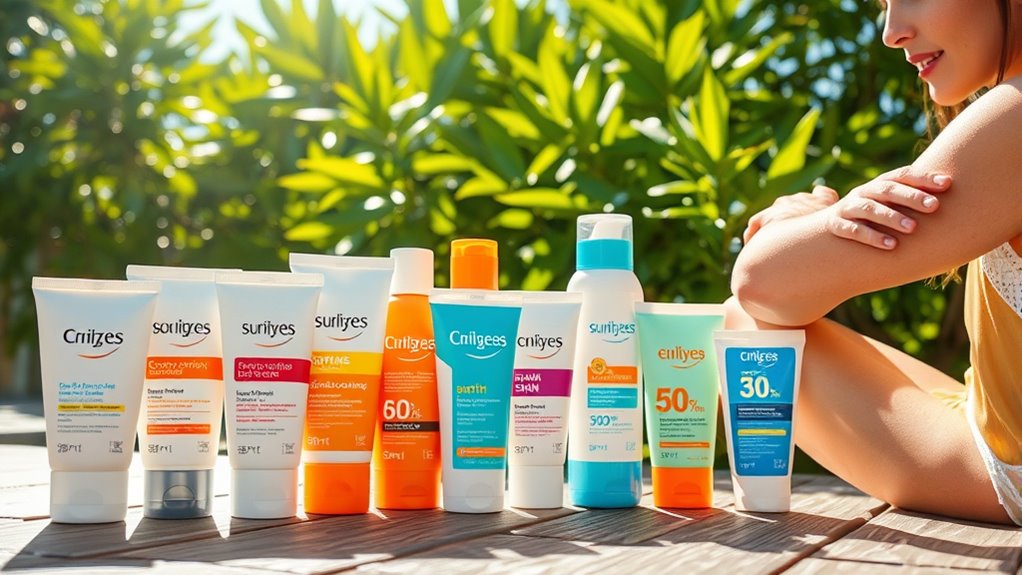
Choosing the right sunscreen depends on your skin type, so pick one that suits your needs. Pay attention to sun protection factors to make certain of effective coverage, especially during peak hours. Remember to apply generously and reapply regularly to stay protected all day long. Additionally, selecting a sunscreen with high color accuracy can help ensure that your skin’s natural tone is preserved under different lighting conditions. For sensitive skin, opt for formulations that are mineral-based to reduce the risk of irritation and chemical exposure. Using sunscreens with broad-spectrum protection can also provide defense against both UVA and UVB rays, offering comprehensive coverage. Staying informed about AI vulnerabilities can also promote better product safety and innovation in skincare formulations. Incorporating photosensitivity considerations into your routine can further enhance your protection strategies and help prevent skin damage from unexpected UV exposure.
Skin Type Compatibility
The right sunscreen depends on your skin type, as different formulations address specific needs and sensitivities. For sensitive skin, choose mineral sunscreens with zinc oxide or titanium dioxide, which are gentle and less likely to cause irritation. If you have oily or acne-prone skin, look for oil-free, non-comedogenic formulas that won’t clog pores or increase breakouts. For dry skin, opt for sunscreens with added moisturizers like hyaluronic acid or glycerin to keep your skin hydrated. Recognizing your skin type helps you avoid reactions and ensures effective protection. HEPA filtration in air purifiers can help reduce allergens and pollutants that may aggravate sensitive skin conditions. Additionally, selecting products with appropriate ingredients tailored to your skin type can enhance overall skin health during sun exposure.
Sun Protection Factors
Understanding the appropriate Sun Protection Factor (SPF) for your skin type is essential to maximize protection without unnecessary exposure. If you have fair skin that burns easily, choose a broad-spectrum sunscreen with at least SPF 30 or higher. For medium skin tones that tan gradually, SPF 15 to 30 usually suffices. Those with darker skin may opt for SPF 15, but remember, they still need protection against UV rays. If you’re active or plan to spend extended time outdoors, higher SPF provides better coverage. Keep in mind, SPF indicates how long your skin is protected compared to no sunscreen, so select accordingly based on your activity level and sun intensity. Always match your SPF to your skin’s sensitivity for effective, safe sun protection. Additionally, understanding mammography guidelines can help you stay proactive about your health and detect issues early. Recognizing your skin type helps in choosing the most suitable sun protection strategy. Moreover, knowing your skin’s sensitivity level can guide you in selecting additional protective measures such as clothing or shade. Incorporating yoga into your daily routine can also promote overall well-being and resilience.
Application & Reapplication
Since applying sunscreen correctly is essential for effective protection, you should start by selecting a product suited to your skin type. For oily or acne-prone skin, opt for a non-comedogenic, oil-free formula that won’t clog pores. If your skin is sensitive, choose a mineral-based sunscreen with zinc oxide or titanium dioxide to reduce irritation. For dry skin, look for hydrating sunscreens with added moisturizers.
Remember, proper application and reapplication are key:
- Apply generously 15 minutes before sun exposure.
- Reapply every two hours, or immediately after swimming or sweating.
- Use enough product to cover all exposed areas thoroughly.
The Importance of Applying Sunscreen Correctly and Frequently
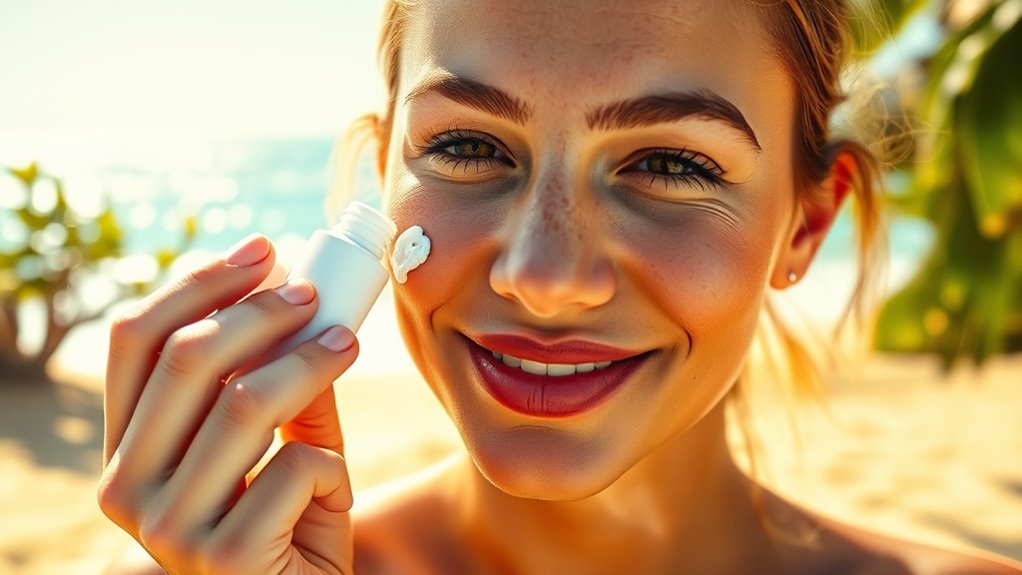
Applying sunscreen correctly and frequently is essential to effectively protect your skin from harmful UV rays. To do this, start with a generous amount—about one ounce—covering all exposed areas evenly. Don’t forget spots like your ears, neck, and the tops of your feet. Apply sunscreen 15 minutes before heading outside, giving it time to absorb. Reapply every two hours, or immediately after swimming, sweating, or towel drying. Use a broad-spectrum sunscreen with at least SPF 30 for ideal protection. Remember, even on cloudy days or in the shade, UV rays can reach your skin. Consistent, correct application minimizes your risk of sunburn, premature aging, and skin cancer. Staying vigilant with proper sunscreen habits helps you enjoy summer safely and maintain healthy skin. Incorporating advanced sun protection technology can further enhance your defense against UV damage. Additionally, choosing sunscreens with broad-spectrum protection ensures coverage against both UVA and UVB rays, providing more comprehensive skin defense. Regularly reapplying sunscreen is especially important when engaging in outdoor activities, as UV exposure can vary throughout the day. Using proper application techniques also ensures maximum coverage and effectiveness of your sunscreen.
Incorporating Protective Clothing and Accessories Into Your Routine

After thoroughly applying sunscreen, adding protective clothing and accessories can considerably boost your defense against UV rays. Wearing wide-brimmed hats, lightweight long-sleeve shirts, and UV-protective sunglasses creates a physical barrier that shields your skin from harmful rays. These items not only block sunlight but also reduce the need for frequent reapplication of sunscreen, especially when spending extended time outdoors. When choosing clothing, look for fabrics with UPF ratings for added protection. Accessories like hats and sunglasses also help prevent eye damage and skin aging around the face. Incorporating sound healing science into your wellness routine can promote relaxation and reduce stress while enjoying your sunny days. Incorporating waterpark hotel amenities into your vacation planning can enhance your overall experience while maintaining sun safety. Incorporating fabric decorating markers into your wardrobe can add a layer of personalization while maintaining sun safety. Incorporating precious metals investments into your overall financial planning can provide additional stability and security for your future. Remember, combining these protective measures with sunscreen maximizes your defense, ensuring you stay safer and healthier in the sun. Incorporate these habits into your routine to enjoy summer fun without compromising your skin’s health. Using appropriate clothing and accessories in your sun protection strategy can enhance your overall defense against UV exposure.
Seeking Shade During Peak Sun Hours

During peak sun hours, from 10 a.m. to 4 p.m., seeking shade helps protect your skin from intense UV rays. You can find shade options like trees, umbrellas, or covered structures, each offering different benefits. Taking advantage of these shaded spots reduces your risk of sunburn and long-term skin damage. Using self-shading devices such as outdoor shade structures can provide consistent protection during outdoor activities. Additionally, choosing high-quality sun protection gear can further minimize your exposure to harmful rays. Being aware of sun exposure risks can help you make better decisions for your skin health.
Optimal Shade Timing
To protect your skin effectively, seek shade during the peak sun hours, typically between 10 a.m. and 4 p.m., when the sun’s rays are the strongest. During these hours, your skin is most vulnerable to sun damage and UV radiation. By timing your outdoor activities outside this window, you reduce your risk of sunburn, premature aging, and skin cancer. Keep in mind that the intensity of sunlight varies based on your location and weather conditions, so adjust your shade-seeking accordingly. Being mindful of ideal shade timing helps you balance outdoor enjoyment with skin protection. Remember, even if you’re in the shade, UV rays can reflect off surfaces and still cause damage, so complement shade-seeking with other sun safety practices.
Shade Options and Benefits
Seeking shade during peak sun hours offers a variety of options that can help protect your skin effectively. You can choose natural shade from trees, which not only blocks harmful rays but also provides a cooling environment. Umbrellas and pop-up canopies are portable alternatives that give you control over your shade, ensuring you stay protected wherever you go. Covered patios and awnings offer more permanent solutions, especially if you spend extended periods outdoors. The benefits are clear: shade reduces your risk of sunburn, skin aging, and long-term skin damage. It also helps keep your body temperature down, preventing overheating. Incorporating these shade options into your summer routine lets you enjoy the sun safely while minimizing exposure to harmful UV rays.
Staying Hydrated for Healthy Skin
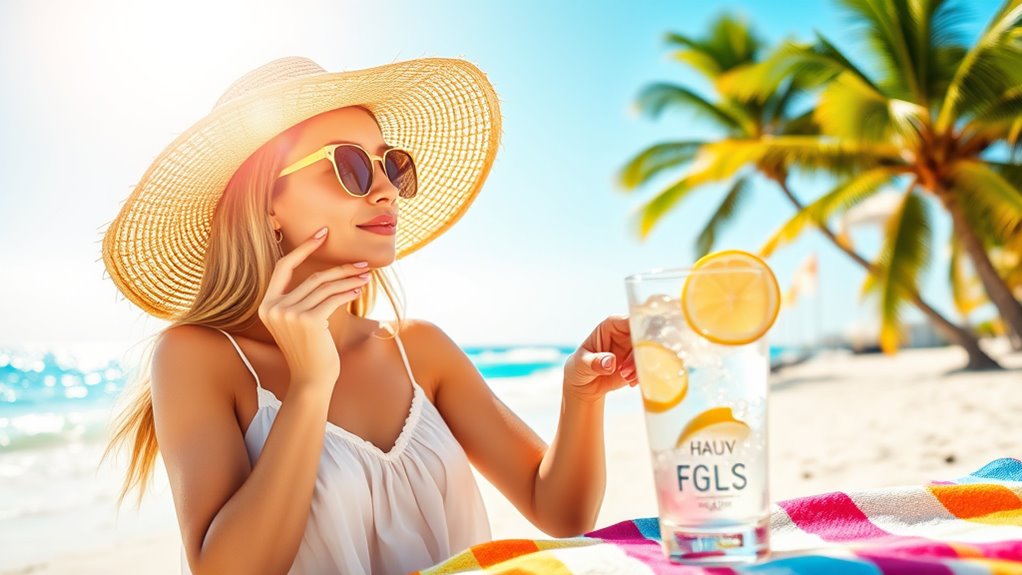
Have you ever noticed how your skin looks dull or feels dry during hot summer days? Staying hydrated is key to maintaining healthy, glowing skin. When you drink enough water, you help flush out toxins, keep your skin plump, and prevent dryness. Proper hydration also supports the skin’s natural barrier, reducing sensitivity and irritation from sun exposure. To maximize benefits, consider these tips:
Staying hydrated keeps your skin glowing and protected from summer’s harsh effects.
- Carry a water bottle and sip regularly throughout the day
- Incorporate hydrating foods like watermelon and cucumbers into your diet
- Limit drinks with caffeine or alcohol, as they can dehydrate you
Incorporating Antioxidants to Combat Sun Damage

Adding antioxidants to your skincare routine helps strengthen your skin’s defenses against sun damage. You can boost these benefits by eating foods rich in antioxidants like berries, nuts, and leafy greens. Together, these strategies can help protect your skin and keep it healthy all summer long.
Antioxidants Boost Skin Defense
Since sun damage produces free radicals that can harm your skin, incorporating antioxidants into your summer skincare routine is essential. Antioxidants neutralize these free radicals, reducing inflammation and preventing premature aging. When you add antioxidant-rich products, you strengthen your skin’s natural defenses against UV rays and environmental stressors. This not only helps repair damage but also keeps your skin looking youthful and vibrant. To maximize benefits, choose serums or creams with ingredients like vitamin C, vitamin E, or niacinamide. Remember, antioxidants work best when combined with broad-spectrum sunscreen. Consistent use boosts your skin’s resilience, making it more resistant to sun-induced damage over time. By prioritizing antioxidants, you’re actively supporting your skin’s ability to fight off damage and maintain a healthy glow.
Foods Rich in Antioxidants
Consuming a variety of antioxidant-rich foods can substantially bolster your skin’s defenses against sun damage. Fruits like berries, oranges, and kiwis pack vitamins C and E, which help neutralize free radicals caused by UV rays. Dark leafy greens such as spinach and kale are high in lutein, protecting your skin from oxidative stress. Nuts and seeds, like almonds and sunflower seeds, provide essential fatty acids that support skin repair. Tomatoes contain lycopene, a powerful antioxidant that enhances sun protection. Incorporating these foods into your diet can strengthen your skin’s resilience and reduce signs of aging caused by sun exposure. Remember, a balanced intake of antioxidants works synergistically to keep your skin healthier and better equipped to handle the summer sun.
Recognizing the Signs of Sun Damage and Skin Aging
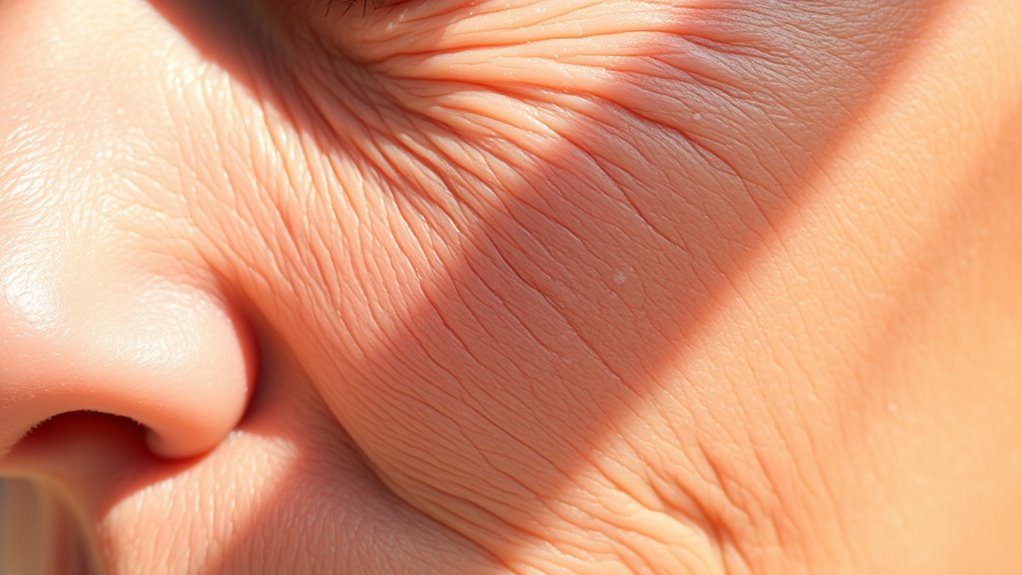
Sun damage and skin aging often show subtle signs that can be easy to overlook at first. You might notice changes in your skin’s texture or tone before visible issues appear. Keep an eye out for fine lines that deepen over time, uneven pigmentation, or rough patches that feel different when you touch them. These signs indicate your skin has been affected by sun exposure and aging. Recognizing these early signals helps you take action before more serious damage occurs.
Watch for subtle signs like uneven tone and fine lines to catch sun damage early.
- Fine lines and wrinkles forming around your eyes and mouth
- Uneven skin tone or dark spots that develop gradually
- Dryness or rough patches that don’t improve with usual skincare routines
Tips for After-Sun Skincare and Repair
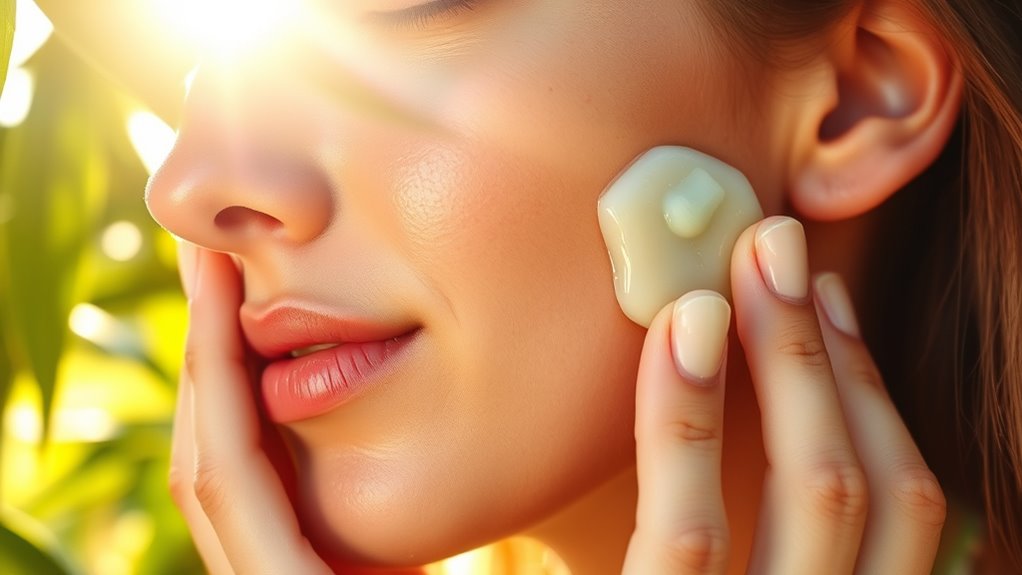
After a day in the sun, your skin needs proper care to recover and minimize damage. First, apply a cool, soothing moisturizer containing aloe vera or chamomile to calm inflammation. Hydrate well by drinking plenty of water to replenish lost moisture. Avoid harsh soaps or scrubbing, which can irritate your skin further. Consider using a gentle, hydrating mask or serum with antioxidants to repair damage.
| Tip | Benefit |
|---|---|
| Use aloe vera | Soothes and cools skin |
| Moisturize regularly | Locks in moisture and speeds healing |
| Hydrate internally | Supports skin repair from within |
| Avoid further sun exposure | Prevents worsening damage |
Lifestyle Habits to Maintain Skin Health Throughout Summer
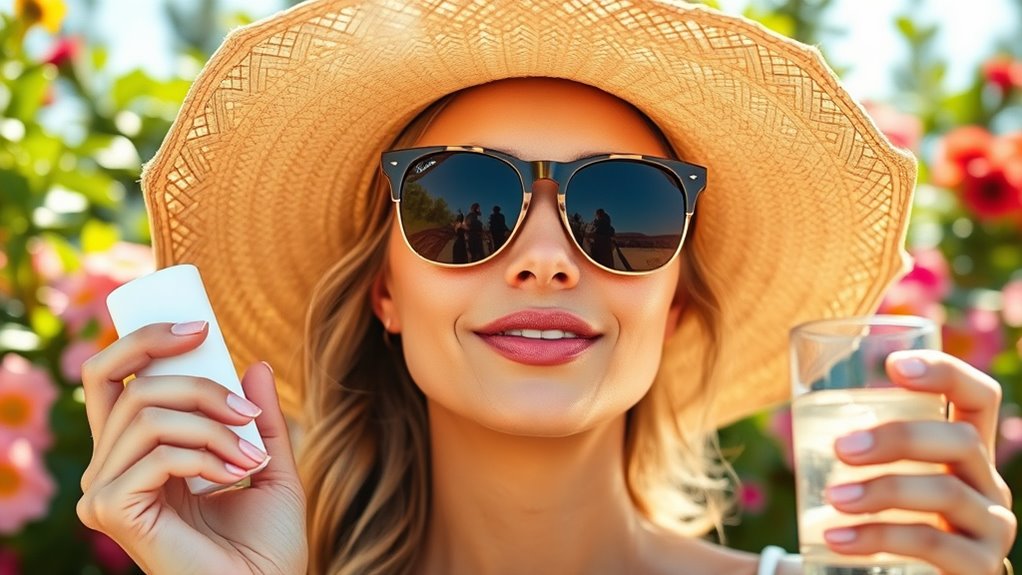
Maintaining healthy skin throughout summer requires adopting consistent habits that protect and nourish your skin daily. You should prioritize staying hydrated, as water helps keep your skin plump and resilient against sun damage. Incorporate a balanced diet rich in antioxidants, vitamins, and healthy fats to support skin repair and defense. Additionally, establish a daily skincare routine that includes cleansing, moisturizing, and applying broad-spectrum sunscreen.
Remember these key habits:
- Stay hydrated to maintain skin elasticity and flush out toxins.
- Eat nutrient-rich foods for internal protection and repair.
- Stick to a skincare routine that includes sun protection and gentle cleansing.
Frequently Asked Questions
Can Certain Foods Help Protect My Skin From Sun Damage?
Certain foods can help protect your skin from sun damage. Foods rich in antioxidants like berries, dark chocolate, and nuts fight free radicals caused by UV rays. Including omega-3 fatty acids from fish or flaxseeds can reduce inflammation and support skin repair. Eating plenty of colorful fruits and vegetables provides vitamins A, C, and E, which strengthen your skin’s defenses. Remember, diet complements sunscreen and protective clothing for summer skincare.
How Does Skin Type Influence Sun Protection Needs?
Imagine you’re in a medieval fair, wielding your shield. Your skin type influences how much sun protection you need—fair skin burns easily, so you should wear SPF daily and seek shade, while darker skin has more melanin, offering some natural protection but still needs sunscreen. Knowing your skin type helps you choose the right SPF level and protective measures, ensuring your skin stays healthy and safe in the sun.
Are There Natural Remedies to Soothe Sunburned Skin?
You can soothe sunburned skin with natural remedies like aloe vera, which cools and moisturizes. Applying coconut oil helps reduce inflammation, while a cool compress can ease discomfort. Drinking plenty of water aids in healing. Oatmeal baths also soothe irritated skin. Remember, though, these remedies provide relief, but it is crucial to protect your skin from further damage by staying out of the sun and using proper SPF.
Does Sunscreen Expire or Lose Effectiveness Over Time?
While it’s tempting to rely on familiar products, you should know that sunscreen does have a shelf life. Over time, its ability to shield your skin from harmful rays diminishes, even if it looks fine. Generally, you should check the expiration date on the packaging and replace it every one to three years. Using fresh sunscreen guarantees you get the best protection and keeps your skin safe under the sun.
How Often Should I Reapply Sunscreen During Outdoor Activities?
You should reapply sunscreen every two hours during outdoor activities to maintain protection. If you’re sweating heavily or swimming, reapply immediately after. Wearing broad-spectrum sunscreen with at least SPF 30 helps block harmful UV rays. Don’t forget to cover often overlooked areas like your ears, neck, and the tops of your feet. Regular reapplication guarantees your skin stays protected and reduces the risk of sun damage and skin cancer.
Conclusion
As you enjoy sunny days, remember that protecting your skin becomes second nature—just like reaching for your sunglasses or a invigorating drink. When you stay vigilant with sunscreen and protective gear, you’ll notice your skin glowing and aging gracefully. Coincidentally, these habits blend seamlessly into summer’s rhythm, helping you savor every moment outdoors while keeping your skin healthy and radiant. So, embrace these simple steps, and let your summer memories be worry-free and beautiful.
